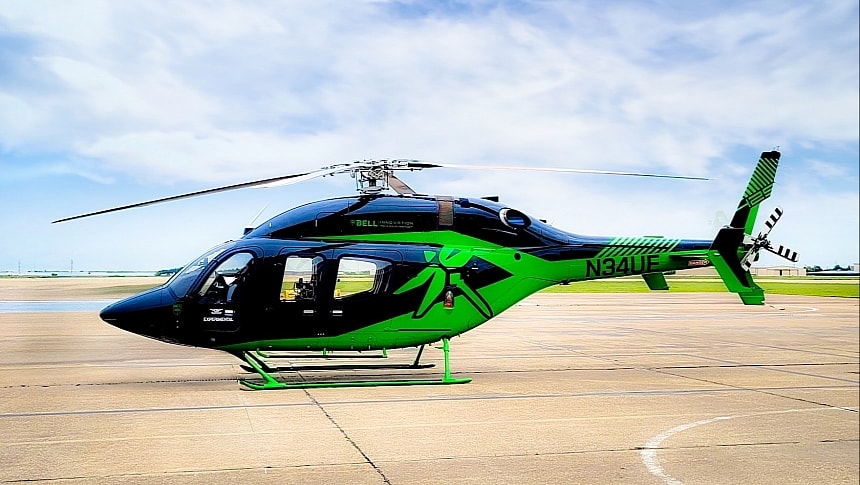Testing autonomous flight technologies is a tricky business. Many aviation companies, be they startups or established players, create entirely new aircraft for this purpose alone, and that can prove very costly. Few, however, are using existing platforms, but that, most of the time, leads to safety concerns. What is an aviation company to do, then?
American aerospace company Bell thinks it has the answer. Originally born in 1935, and given another shot at stardom when it was purchased by Textron in 1960, Bell has a long tradition of experimenting in novel ways, and that's exactly what it's doing now.
Like all other companies in aviation, Bell is betting on autonomous tech for the future of its aircraft, to a much greater degree than it offers now. But instead of building a platform from scratch to test its ideas, the company transformed a commercial 429 helicopter in a novel way.
This helicopter has been around since 2009, serving the needs of corporations, health, education, maintenance and support (HEMS) organizations, public safety agencies, and even utility companies.
The thing is a light, twin-engine machine powered by a pair of Pratt & Whitney turboshaft engines capable of developing up to 719 shaft horsepower each. They give the helicopter a top speed of 178 mph (287 kph), and a maximum range of 473 miles (761 km).
Normally the helicopter is controlled to a large degree by humans, but the future of aviation will require it and all others of its kind to incorporate a long list of autonomous systems. And that's why Bell converted one of these 429s into a research platform.
Put together by the company's Advanced Programs team the helo is now officially called Aircraft Laboratory for Future Autonomy, or ALFA. The main thing that sets it apart from its kin is the fitting of a fly-by-wire control system aimed at reducing pilot workload while increasing safety.
With the hardware on, the 429 will be able to perform flight maneuvers in an autonomous way in a bid to "inform future autonomous technology development." But that's not necessarily what makes the design interesting.
As stated earlier, giving an autonomous system control over a crewed aircraft for testing purposes could prove a bit dangerous, and that's why Bell separated the safety functions from flight control in the ALFA. This approach will allow the helicopter maker to develop and test new autonomous tech without compromising safety.
Although relatively new in the world, the ALFA has already conducted its first test flight at the Bell Commercial Assembly and Delivery Centre in Mirabel, Quebec, Canada. We're not told when the flight occurred, but we do know the helo has since moved to the Flight Research Center in Fort Worth, Texas for further testing.
Bell did not disclose the exact tech it is putting through its paces on this platform, and it did not reveal when we're to expect the first real-world results.
Like all other companies in aviation, Bell is betting on autonomous tech for the future of its aircraft, to a much greater degree than it offers now. But instead of building a platform from scratch to test its ideas, the company transformed a commercial 429 helicopter in a novel way.
This helicopter has been around since 2009, serving the needs of corporations, health, education, maintenance and support (HEMS) organizations, public safety agencies, and even utility companies.
The thing is a light, twin-engine machine powered by a pair of Pratt & Whitney turboshaft engines capable of developing up to 719 shaft horsepower each. They give the helicopter a top speed of 178 mph (287 kph), and a maximum range of 473 miles (761 km).
Normally the helicopter is controlled to a large degree by humans, but the future of aviation will require it and all others of its kind to incorporate a long list of autonomous systems. And that's why Bell converted one of these 429s into a research platform.
Put together by the company's Advanced Programs team the helo is now officially called Aircraft Laboratory for Future Autonomy, or ALFA. The main thing that sets it apart from its kin is the fitting of a fly-by-wire control system aimed at reducing pilot workload while increasing safety.
With the hardware on, the 429 will be able to perform flight maneuvers in an autonomous way in a bid to "inform future autonomous technology development." But that's not necessarily what makes the design interesting.
As stated earlier, giving an autonomous system control over a crewed aircraft for testing purposes could prove a bit dangerous, and that's why Bell separated the safety functions from flight control in the ALFA. This approach will allow the helicopter maker to develop and test new autonomous tech without compromising safety.
Although relatively new in the world, the ALFA has already conducted its first test flight at the Bell Commercial Assembly and Delivery Centre in Mirabel, Quebec, Canada. We're not told when the flight occurred, but we do know the helo has since moved to the Flight Research Center in Fort Worth, Texas for further testing.
Bell did not disclose the exact tech it is putting through its paces on this platform, and it did not reveal when we're to expect the first real-world results.













